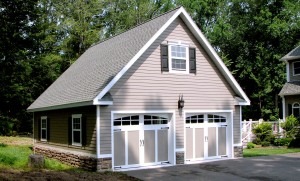How Attached Should You Be To Your Garage?
 A number of factors go into making one of the most important decisions you face when it comes to building a new garage: will your new structure be an attachment to your existing home, or will it be a standalone structure located elsewhere on your property?
A number of factors go into making one of the most important decisions you face when it comes to building a new garage: will your new structure be an attachment to your existing home, or will it be a standalone structure located elsewhere on your property?
There are pros and cons to each option. And as a leading custom garage builder, we know that giving strong consideration not only to what your immediate plans for the garage are but also what uses you may have for the building in the future will give you a good idea which direction to go. You should also be aware, however, that in some situations physical limitations of the property or the overall aesthetic of the community may go a long way to making this decision regardless of purpose.
HOW THESE OPTIONS EVOLVED
In the early days of the automobile, gas stations were far from plentiful and those who owned cars had need to store not only the auto but also a supply of gasoline. The garage we know today evolved from old carriage houses, which were ideal for this purpose as they kept a very real fire hazard away from main living quarters.
Early automobiles were luxuries that only the wealthy could afford. As the automobile evolved and prices began to fall to the levels where the average family could afford one, the need to quickly build garages grew rapidly. Folks discovered that these new buildings had uses beyond automobile storage. Garages started to double as workshops, dens and, in a pinch, additional living space.
More people owning cars created a market that supported more and more filling stations, and the need for families to store their own fuel dwindled. With it dwindled the fire hazard, and folks not only felt more comfortable keeping their autos closer to the home, they also discovered it was much better to get out of the car and go right into the house than to have to lug purchases, luggage or whatnot from a garage at the other end of their property – especially in foul weather. In short order, the garage changed from a separate, removed structure to an adjacent space built as an attachment to the main house.
COMMUNITY AESTHETICS AND PROPERTY RESTRICTIONS
As a result of this evolution, the homes within a given neighborhood will tend to be standardized to either detached garages (often seen in communities dating back to the early 20th century) or attached garages (common in post-war, suburban communities). That neighborhood standard may well be the decision-maker for you. Neighbors may look askance at a home sporting an attached garage visible from curbside amid a development of homes with garages tucked deeper into the property and out of view.
Similarly, the decision to build a separate structure rather than one attached to the home may need to be made based on your property’s footprint. Properties that are long and narrow, such as those often found with townhouses or duplexes, are not particularly attachment-friendly but are ideal for a detached garage behind the main house. Suburban lots, which often are more square and share large backyard spaces, may find a detached garage to be disruptive to that shared space but offer the ideal arrangement for extending the main structure.
PURPOSE-BASED CHOICE
If neither community nor property limitations are considerations for you, your guide to determining which type of structure to build should be your purpose behind building it. Are you building a garage because, quite frankly, you’ve come through the front door of your home soaked by rain or shivering cold too many times? Are you hoping to gain additional usable livable space above the garage proper? Will you likely use storage space for items you might want easy access to, such as a second refrigerator? Clearly, an attached garage would be the proper choice here.
On the other hand, if you are considering using your garage as a workshop, or plan on doing a great deal of tinkering with your car, having a separate garage away from the house can help reduce or avoid noise pollution. If you plan to store volatile materials such as gasoline cans, consider that a fire in a separate structure will not threaten your main living area.
TALK TO THE EXPERTS
If you’re not certain which type of structure will work best for your property and your needs, talk to one of the knowledgeable experts here at Conestoga. They’ll be happy to listen to what you hope to achieve and show you a number of options to help you build a garage you will be pleased with for many years to come. Contact us today to ask questions and request a quote.
